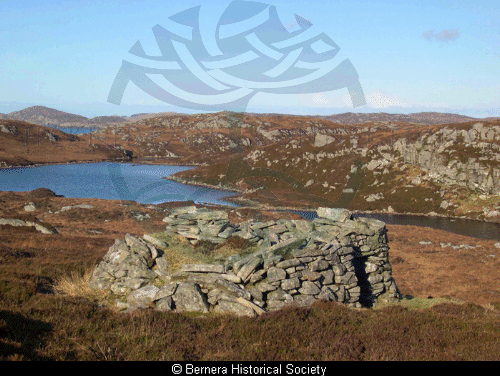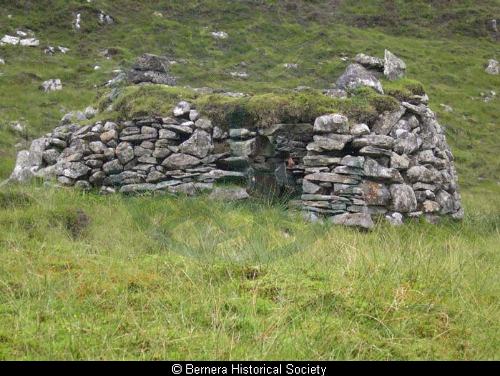44023: At the Sheiling – 1927
Flora Macdonald, Lundale, recounts her young days at the sheiling; from ‘A study of sheilings and sheiling sites’ conducted by students of the University of Birmingham
In 1927 when I went to the sheiling the tradition had already begun to die out in Uig. People began to have fewer and fewer cattle so only four sheilings were in use for the whole of our village. Consequently four girls took everyone’s cattle to the pasture; this consisted of twenty heifers and three cows. One cow was always left on the croft to provide the family with milk. A shepherd took the sheep to the moorland grazng. In the past generation an older woman called a ‘banachan’ would have been in charge to make butter and cheese, but we only made butter for our own use at the sheiling. Twice a week two of us made the long trip home (about twenty miles) with the cream which we carried in pails covered with salt-cured sheepskins.
Some families had two sheilings. One was used for six weeks from mid June until August; the other (half-way sheilings) were situated near to the village of Kirkibost and were used from August until September. From then onwards the entire village cows would move onto the common pasture. Teenage boys enjoyed droving the cattle out to the summer pasture and the men went ahead of us to do any repairs to the sheilings.
The sheilings were sturdily built with a double wall of stone filled with earth; they were approximately 9×7 feet in size and were extremely cosy. Two doors were used; one was sealed up with blocks of turf against the wind; we never felt any draughts. A fire was placed against one of the walls with a raised platform beside it covered with a grid for pots and pans. Next to that was a recess fitted with wooden shelves for storage, this was covered with a curtain. A bench was built near the fire, which was very comfortable. It consisted of a stone platform covered with turf, packed down on top with heather fronds and grasses. This was then covered with sacking and finally a decorative cover. The walls had alcoves for the milk basins, which were then covered over with bleached canvas dustsheets to keep the milk clean. Walls were built to four feet high but one could stand erect to six feet in the middle underneath the chimney – this was an oval shaped opening with a turf damper. The roof was held down with ropes and stone weights.
A stream was situated nearby in which we bathed. The cows lay around until 2pm chewing the cud; they would then rise and go to the pasture until the next morning. Meanwhile we would clean up the dung with heather brooms to the periphery of the green, this meant that it was widened year by year.
We had visitors occasionally especially on a Sunday; our boyfriends would call any time. We always had a good supply of food in so that we could entertain, this added to our enjoyment of life at the sheiling and, although I only spent one summer there, the memories are very vivid and very happy.
Details
- Record Type:
- Story, Report or Tradition
- Date:
- 1998
- Type Of Story Report Tradition:
- Other
- Record Maintained by:
- HC

